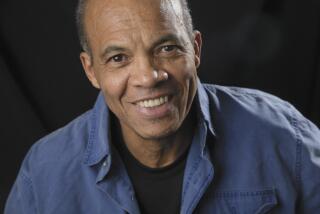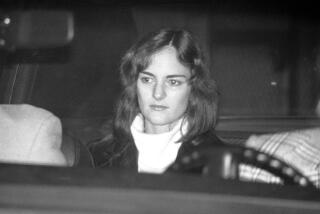‘Breach of Peace’ fills in the blanks on the ‘Freedom Riders’
July 6, 2008
The story was already written: Vividly rendered on those young faces -- excited, angry, naive, fearful, idealistic. But it was only the first leg of their journey. That’s what first struck Eric Etheridge when he first laid eyes on a trove of old mug shots -- men and women, black and white -- who came to be known as the “” Freedom Riders.”
The images, standard head-and-shoulder shots, were stored for safekeeping by the Mississippi State Sovereignty Commission, an agency created in 1956 to protect the state from “federal encroachment”; meaning to resist all change in the racial status quo after the Supreme Court’s 1954 Brown vs. Board of Education decision, which had desegregated public schools.
Each photograph contained just the most pertinent information: Police department. Booking number. Date of arrest. But Etheridge felt a hint of something more embedded there. “As soon as I saw them, I realized that they were something pretty exquisite.”
For Etheridge, who was, as he puts it, “a magazine editor between jobs looking to give myself an assignment,” it was an obvious, open question: “Where are they now? Where did this road eventually take them?”
His new book, “Breach of Peace: Portraits of the 1961 Mississippi Freedom Riders,” fills in the subsequent chapters of these activists’ stories. As it happened, all these years later, these men and women would describe the same impetuses he’d glimpsed in their faces -- “naivete,” “idealism,” “anger” -- to describe what was in their head, or heart, in that earlier instant. They spoke to Etheridge candidly about the complexities that led them to board trains or buses and travel through the troubled American South during the spring and summer of 1961 -- testing the power of the Supreme Court’s ruling that decreed that interstate travel be desegregated.
Eventually, their act of persistence would alter the course of history, paving the path for the Civil Rights Act of ‘64, the Voting Rights Act of ’65 and the War on Poverty -- and the stream of citizen activism that would follow.
As Etheridge would come to learn, these several hundred protesters had come to this crossroads from all points on the map -- geographically, ideologically, spiritually. Before it was all over many would be beaten; one bus was set afire; another was ambushed by the Ku Klux Klan. Mass arrests were made, and many protesters found themselves behind the bars at Parchman, Mississippi’s infamous state penitentiary. There they buoyed themselves with what become known as freedom songs.
Etheridge, a son of the South, was only 4 that summer. He grew up in Carthage, Miss., just 60 miles north of Jackson. Back then, the segregated South wasn’t something that he understood in words; rather, it was atmosphere, something that was observed in the everyday black-white divisions -- school, church, transit. Soon enough, he’d move north, first for college in Nashville, then to New York in the late ‘70s to begin a career in journalism, working as an editor at Rolling Stone and other publications.
When the Sovereignty Commission released its files to the public in 1998, that milestone revelation stuck in his head -- though it would take six more years for him to get there. The paradox wasn’t lost on him: “This was the commission whose job it was to stop progress and preserve segregation,” said Etheridge. “Here it was. . . this amazing documentation of the Mississippi portion of the Freedom Rides, and they deserved a wider audience.”
Taking a new look
He wasn’t the first to lay eyes on the mug shots or incorporate them into a larger project. But Etheridge, who had begun fiddling around more and more with photography, was interested in making new portraits. “I thought I would treat them as their own entity.” The commission had already made the first step easy -- along with the photos, the commission had collected personal information. “So I had everybody’s name, birthday, birthplace and current address as of ’61.” Plugging the information into Internet search sites, he began to make his way through the list. Some of the subjects were ready right away. Others were guarded or skeptical about his intentions. “One person said he didn’t want to be photographed. Another didn’t understand quite what I wanted to do,” said Etheridge. “They [all] were surprised to hear from some guy who was interested in this moment in their lives.” His icebreaker: “Have you seen your mug shot from 1961?” Most of them, said Etheridge, didn’t know it existed.
When writer and publisher James Atlas happened upon Etheridge’s project -- two portraits and their corresponding mug shots -- while paging through the New York Times Magazine, he was at his own crossroads. Atlas was in the process of starting his own independent press, Atlas & Co. “But my thinking had been kind of inchoate,” he said. “But when I saw those four photographs. It was somehow ordained . . . that I had a social and political mission.” Those images were still potent symbols; a reminder that each of us is capable of stepping forward, affecting change. Atlas put calls out to find him: So ultimately, “Eric’s book helped me articulate what I wanted to do.”
The portraits show the predictable transformation: gray hair, lined faces -- just one layer of the journey. But for Etheridge, there is something about what lives on in the eyes -- that anger or satisfaction, detachment or sadness. “Many of them shared their life story -- how they were raised, what kind of political understanding they had and how they got involved,” said Etheridge.
Etheridge learned that their paths varied -- they became teachers, car mechanics, graphic designers, longshoremen, pastors -- many of them lifelong activists. Some of them became famous -- Rev. James Lawson, Stokely Carmichael and Rep. John Lewis (D-Ga.) -- and others were proud of their moment in the thick of it but happy to now be working out of the spotlight.
The legacy of the rides
Looking at America’s racial landscape of today -- unemployment, murder rates of black men, statistics enumerating hate crimes-- would they say it had long-range resonance? Were the broken skulls, or the battered pride, worth it in a measurable, enduring way? “I would say that most of them feel that the Freedom Rides -- the civil rights movement of ’60 to ’65 was very successful in accomplishing these very basic things like getting people to vote, ending segregation,” said Etheridge. “I think that they all would feel in varying degrees that the movement stopped short of getting where they thought things should be.”
Etheridge is quick to add, however, that he did much of this work before there was such a thing as a Barack Obama on the horizon, so even these portraits -- these visual statements/oral interludes -- are truly snapshots of an instant, a story still in progress. Now, as Etheridge tours the country promoting the book, sometimes appearing with some of the Freedom Riders themselves, that subject often comes up: that some of the fruits, the tangible measures of success, took 40-plus years to arrive. “It’s a heroic testament,” added publisher Atlas, “to the possibilities for revisiting and advancing the cause of black equality in this country now vindicated by Obama.”
Yet for many of them the vindication came long ago in the moment. “I can’t speak for nobody else,” Freedom Rider Frank Holloway recalls in his interview in “Breach of Peace.” “I didn’t feel like I was a hero or anything like that. I did it and when I stopped doing it, I didn’t feel like anybody needed to reward me or congratulate me or pat me on my back. I did what I felt like I had to do.”
More to Read
The biggest entertainment stories
Get our big stories about Hollywood, film, television, music, arts, culture and more right in your inbox as soon as they publish.
You may occasionally receive promotional content from the Los Angeles Times.










